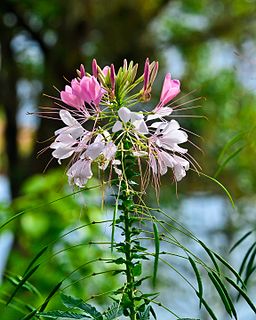
Cleome serrulata, commonly known as Rocky Mountain beeplant/beeweed, stinking-clover, bee spider-flower, skunk weed, Navajo spinach, and guaco, is a species of annual plant in the genus Cleome. Many species of insects are attracted to it, especially bees, which helps in the pollination of nearby plants. It is native to southern Canada and the western and central United States. The plant has often been used for food, to make dyes for paint, and as a treatment in traditional medicine.

Cleome is a genus of flowering plants in the family Cleomaceae, commonly known as spider flowers, spider plants, spider weeds, or bee plants. Previously, it had been placed in the family Capparaceae, until DNA studies found the Cleomaceae genera to be more closely related to the Brassicaceae than the Capparaceae. Cleome and clammyweed, can sometimes be confused. The simplest way to differentiate the two is to compare the seedpods which project out or down on cleome and up on clammyweed.

Cleome hassleriana, commonly known as spider flower, spider plant, pink queen, or grandfather's whiskers, is a species of flowering plant in the genus Cleome of the family Cleomaceae, native to southern South America in Argentina, Paraguay, Uruguay, and southeast Brazil. It has also been introduced to South Asia, including the Haor area of Bangladesh.

Peritoma arborea, is a perennial shrub or bush in the spiderflower family (Cleomaceae) known by the common names bladderpod, bladderpod spiderflower and burro-fat. It has yellow flowers in bloom all months of the year. It emits a foul odor to discourage herbivory from insects.

Cleome gynandra is a species of Cleome that is used as a green vegetable. It is known by many common names including Shona cabbage, African cabbage, spiderwisp, cat's whiskers, chinsaga and stinkweed. It is an annual wildflower native to Africa but has become widespread in many tropical and sub-tropical parts of the world. It is an erect, branching plant generally between 25 cm and 60 cm tall. Its sparse leaves are each made up of 3–5 oval-shaped leaflets. The flowers are white, sometimes changing to rose pink as they age. The seed is a brown 1.5 mm diameter sphere. The leaves and flowers are both edible. The leaves have a strong bitter, sometimes peppery flavor similar to mustard greens.

Cleome platycarpa is a species of flowering plant in the cleome family known by the common names golden bee plant and golden spiderflower. It is native to the western United States from northeastern California to Idaho, including the Modoc Plateau, where it grows on clay and volcanic soils in the sagebrush. It is an annual herb branching at the base into several erect stems up to about 60 centimeters tall. The stems are green tinted with purple, coated densely in glandular hairs, and lined with many leaves. Each leaf is divided into three small leaflets. The top of each stem is occupied by a raceme of many flowers. Each flower has generally four yellow sepals and four yellow petals around a center of many yellow stamens. The fruit is a flat, hairy capsule up to 2.5 centimeters long which hangs on the long, remaining flower receptacle.

Cleome rutidosperma, commonly known as fringed spider flower or purple cleome, is a species of flowering plant in the genus Cleome of the family Cleomaceae, native to tropical Africa. This species is an invasive weed throughout most lowland wet tropical areas of Asia and Australia. It is a very common weed of lawns.

Cleome viscosa, the Asian spiderflower or tick weed is an annual herb that grows up to a meter high. It belongs to the family Cleomaceae. It's considered an invasive species and it is widely distributed in warm and humid habitats across the Americas, Africa and Asia. It is commonly found during the rainy season.
Conospermum bracteosum is a shrub endemic to Western Australia.
Conospermum ephedroides is a shrub endemic to Western Australia.
Conospermum polycephalum is a shrub endemic to Western Australia.
Conospermum quadripetalum is a shrub endemic to Western Australia.
Conospermum unilaterale is a shrub endemic to Western Australia.
Stirlingia seselifolia is a herb or shrub endemic to Western Australia.
Synaphea acutiloba, commonly known as granite synaphea, is a shrub endemic to Western Australia.
Cleome arenitensis is a species of plant in the Cleomaceae family and is found in Western Australia.
Cleome kenneallyi is a species of plant in the Cleomaceae family and is found in Western Australia.
Cleome oxalidea is a species of plant in the Cleomaceae family and is found in Western Australia.
Cleome tetrandra is a species of plant in the Cleomaceae family and is found in Western Australia.
Cleome uncifera is a species of plant in the Cleomaceae family and is found in Western Australia.







